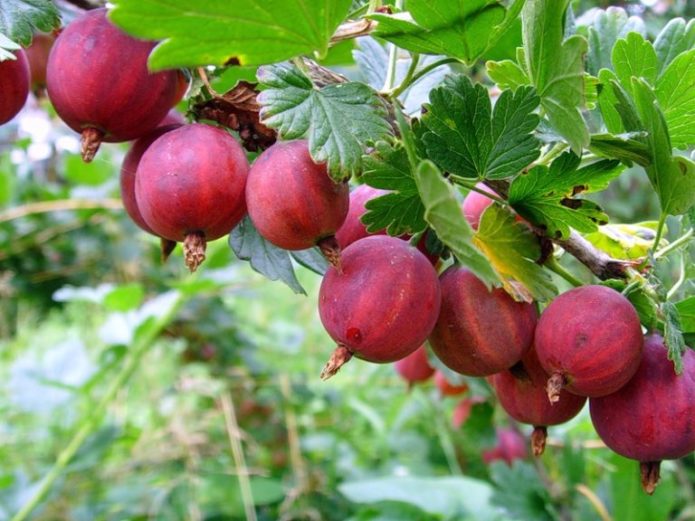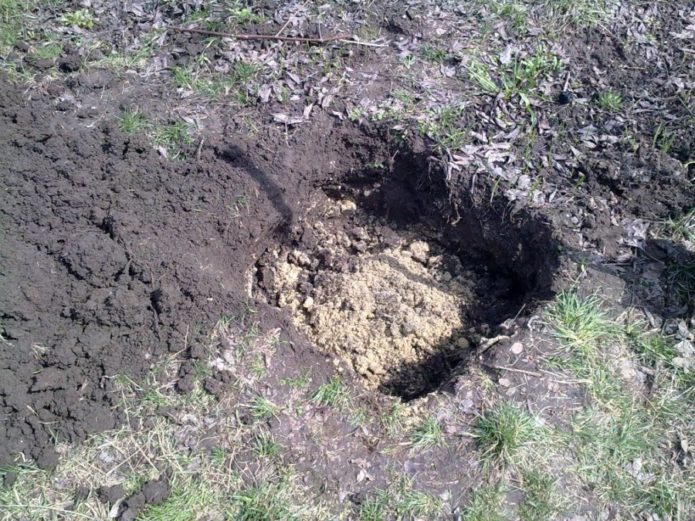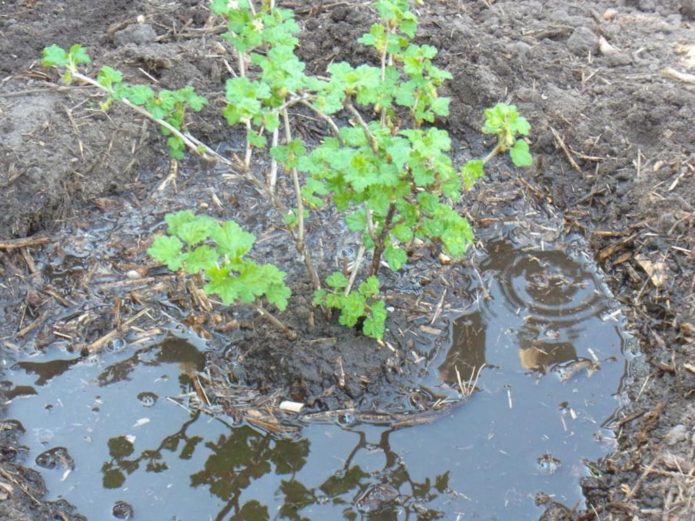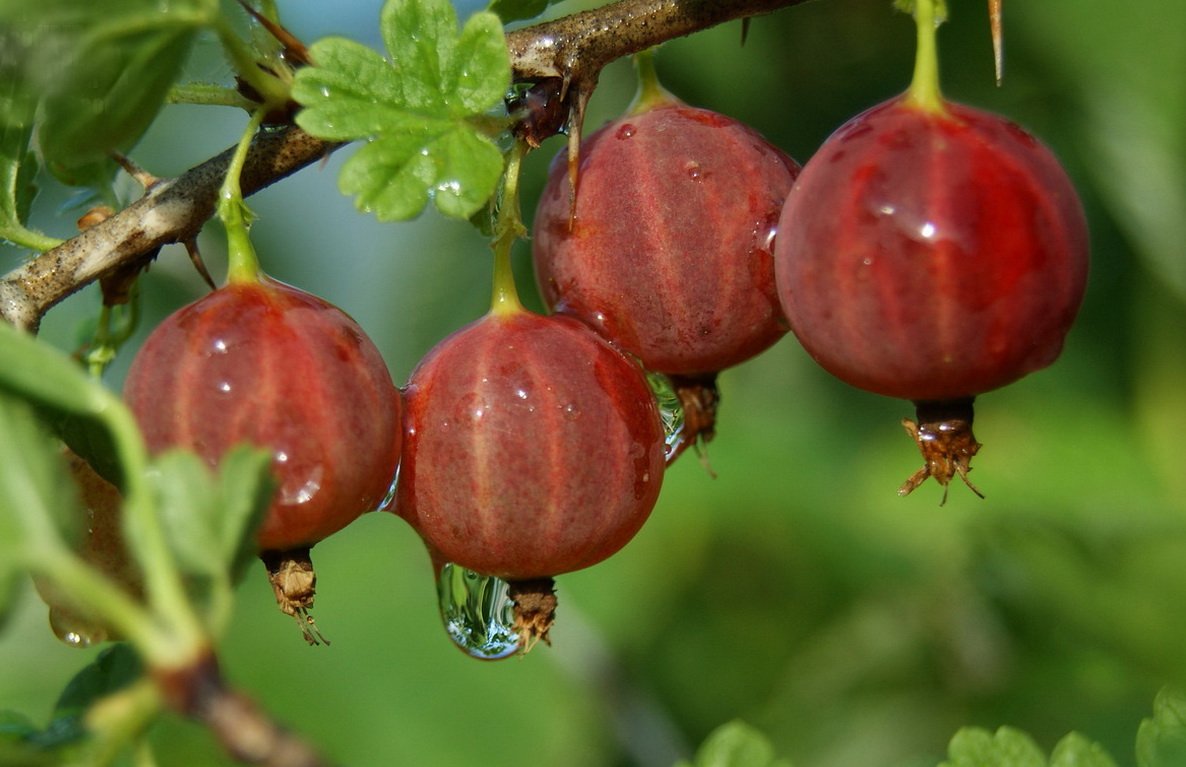Everyone knows that gooseberries are a prickly berry, and this fact is often the main reason that the summer resident does not plant it on his plot. But it turns out that this is not a problem: there are, albeit relatively rare, gooseberry varieties, practically devoid of thorns, the berries of which are not difficult to pick. One of the representatives of such gooseberry varieties is Kolobok, known for more than forty years.
Content
The history of breeding, description and characteristics of the gooseberry variety Kolobok
The Kolobok gooseberry variety was born back in 1977 at the Institute of Horticulture and Nursery. Its "parents" were the varieties Pink 2 and Smena, well known to specialists, whose best qualities were passed on to the offspring. In 1988, the variety took its place in the State Register of Breeding Achievements of our country and is recommended for the Central, Central Black Earth and Volga-Vyatka regions. In fact, it became widespread practically throughout the territory of Russia, including the Siberian territories and regions.
The author of Kolobok IV Popova, in addition to him, created other varieties of gooseberries (for example, Rodnik, Snezhana, Bitsevsky), and each time she tried to breed large-fruited and disease-resistant varieties. Whenever possible, they turned out without or low-thorn, with the fruits of dessert taste.
It cannot be said that Kolobok is the best of the best, but its popularity for almost half a century already testifies to the success achieved in the course of breeding work. The bush of this gooseberry is of medium height, but some shoots reach one and a half meters in length. Medium spreading, the degree of thickening is from medium to above average. Without regular pruning, the bush grows overgrown with numerous thin shoots of the second, third and subsequent orders, but, fortunately, the thorns on them are single and small. The leaves are large, green, three-lobed, slightly glossy, on short petioles. Flowers are arranged one by one or in small groups (2–4 copies each).
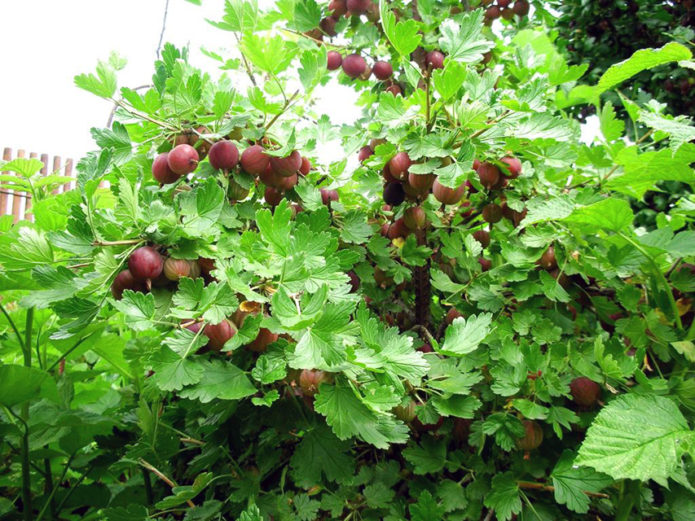
Kolobok has very beautiful large leaves, and the branches are trying to fall to the ground, without support they feel bad
The winter hardiness of the variety is assessed as average: with normal tolerance to severe frosts, the bushes often suffer from unexpected thaws and their consequences. True, after a while they recover at the expense of reserve kidneys. The gingerbread man is highly resistant to the most common diseases of this culture - powdery mildew and anthracnose.
The variety enters the first fruiting early, gives stable yields for many years. According to the ripening period of berries, it is considered mid-season, the yield, depending on the level of agricultural technology, ranges from 4 to 10 (rarely) kilograms per bush. Most of the berries are found on one- and two-year branches. The shape of the berries is close to spherical, they are smooth, weighing 4 to 8 g, located on long stalks. Color - from cherry to dark red, with a significant waxy bloom. Seeds of regular sizes.The dense skin allows the berries to be transported over long distances without losing quality.
The berry taste is rated at 4.5 points: it is pleasant, with a slight sourness. The purpose is universal: from fresh consumption to various types of processing. Some amateurs rate the taste of the berries as mediocre: apparently, there really is nothing outstanding in it, but you can't fool professional tasters!
Features of planting and growing varieties of gooseberry Kolobok
Since the word "average" constantly appears when describing the Kolobok variety, its agricultural technology differs little from that of most other known gooseberry varieties. Like other varieties, it can be planted in both spring and fall, but fall planting is much more reliable. The bushes planted in spring do not have time to settle in a new place as long as the hot weather sets in, bringing the soil to dryness.
Planting gooseberries
Spring planting should be carried out as early as possible, preferably at the very beginning of April. Of course, the planting pit should be ready in the fall, and the roots of the dormant seedling are pre-treated with a solution of any biostimulant - for example, Epin, Zircon or Kornevin. In spring, gooseberries are planted obliquely, about 45about relative to the surface of the earth, and this feature applies only to spring: in the fall, this crop is planted directly. The inclined position of the seedling will give it the opportunity to quickly build up the root system. Shoots during spring planting are greatly shortened, leaving only 3-4 buds on each.
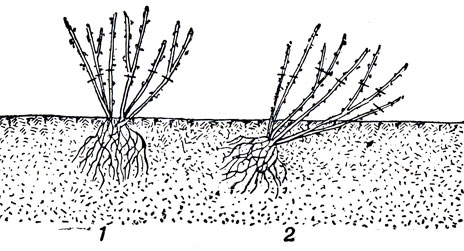
If in the fall gooseberries are planted directly (on the left), then in the spring, so that new roots grow faster, only obliquely
In the case of an autumn planting of gooseberries, the success of this event is almost guaranteed. The timing is chosen so that 15–20 days remain before the first real frosts, otherwise frosts can grab the fibrous roots, the most important for the growth of the bush. In the case of timely planting, before the onset of real frosts, the earth has time to properly compact and settle. During this time, the roots grow moderately, and in the spring, when the temperature is positive, they begin to grow rapidly.
The gooseberry loves sunlight, so it is very undesirable to place it even in partial shade. The best soil for gooseberries is light loam, but with sufficient fertilization, it grows well even on sands. The acidity spread is also large, the gooseberry tolerates pH 5.5. It is important to refine the site long before planting by digging it deeply with careful removal of perennial weeds and applying the usual doses of fertilizers. And only closer to the onset of autumn they dig planting holes. When planting several bushes at the same time, maintain a distance of at least one and a half meters between them. However, it is often easier to prepare not even individual pits, but a common trench of the required size. The autumn planting technique is as follows.
- A landing pit is prepared 15–20 days before planting; it should be about half a meter deep and wide. As always, the lowest, unproductive layer is removed, and the upper, fertile layer is mixed with fertilizers and returned back. Fertilizers are one and a half buckets of humus, 30-40 g of potassium sulfate and 150-200 g of superphosphate. If there is wood ash, a liter jar will not hurt at all. If it's dry, a couple of buckets of water are poured into the pit.
- A good seedling has 4–5 main roots (up to 20 cm long), containing both fibrous roots, and 1–2 external shoots at least 30 cm long. Before planting, only the damaged areas are cut off, and the roots are dipped in a mess of clay and mullein.
- The required amount of soil mixture is removed from the pit, so that the roots of the seedling are freely located.A gooseberry seedling is placed in a pit without tilting, lowering the root collar 5–7 cm below ground level. After that, the roots are straightened, gradually covered with soil, slightly compacted.
- After filling the roots, a bucket of water is poured into the pit. After it has been absorbed, the soil is poured to the top, a roller is made around the seedling and a few more liters of water are carefully poured out.
- The soil around the bush is mulched with humus or at least dry soil. After 3-5 days, watered again, after which a layer of mulch is added.
Gingerbread man planted on time gooseberry will normally overwinter, and in early spring it will start growing.
Gooseberry Care Gingerbread Man
If the technique of planting the gooseberry Kolobok is generally standard and does not differ from the planting of other varieties, then the care has some features associated with the tendency of the bush to thicken. However, the main agronomic measures are the same as in the case of most berry bushes. They include watering, fertilizing, loosening, preventive spraying. However, since Kolobok is an extremely unpretentious variety, most ordinary summer residents do not even pay attention to prevention, and they water it only in case of very dry weather.
At the same time, keeping the soil around the bush in a weed-free and loose state has a positive effect on the quantity and quality of the crop, and weeding and loosening is much easier to carry out on moderately moist soil. Therefore, in the case of a long absence of rain, the Kolobok is watered. This is especially important during intensive berry growth.
Watering is possible using water of any temperature, except clearly ice, but it is advisable to pour it at the root.
Top dressing is started three years after planting. The optimal scheme includes three dressings per season. In early spring, even over thawed-frozen soil, or even over the snow that has not melted, any nitrogen fertilizer (saltpeter, or better - urea) is scattered around the bushes, spending a handful on an adult bush. When melting, urea itself is drawn into the soil, into the root layer. If the moment is missed, then at a later date, the urea must be slightly embedded in the soil with a hoe. At the same time, you can add compost or humus - up to a bucket on a bush, also very lightly working with a hoe.
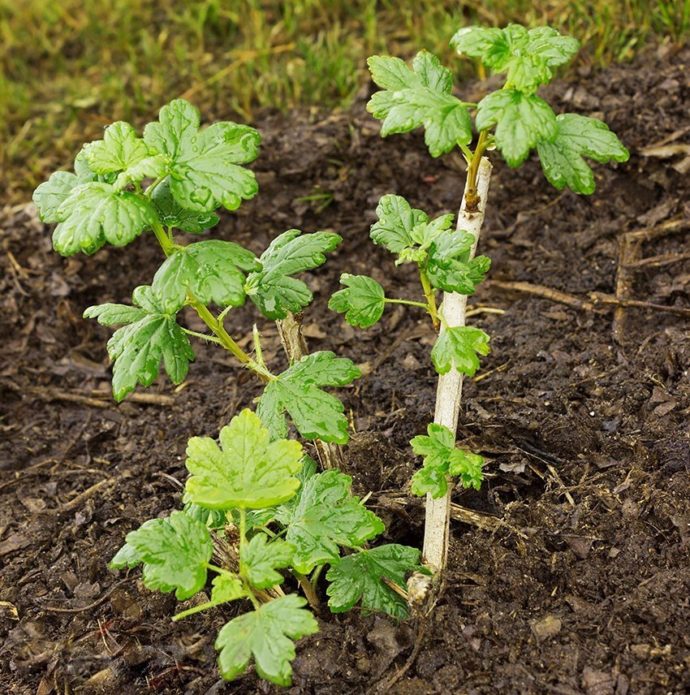
If you scatter good humus around the bush in the spring, it can be strong and not embedded in the soil
If the spring feeding is applied correctly, then only potash and phosphorus fertilizers are used. During flowering, wood ash (about a liter jar) and 30–40 g of superphosphate are embedded under the bush. If it turns out that by this time the shoots have hardly grown, you can add a little urea (half the spring rate). Instead of all this mixture, you can use a complex fertilizer, for example, Azofoska, according to the instructions on the package.
Autumn feeding (in September) practically repeats the summer one and consists of potassium and phosphorus preparations. In late autumn, after the fall of leaves, you can scatter a bucket of humus around the bush. The need for additional fertilizing can arise only when the condition of the bush is clearly unsatisfactory.
Correct pruning of gooseberries Gingerbread man is a guarantee of the longevity of the bush and bountiful harvests. Pruning is aimed at providing better illumination and stimulating the growth of young branches: after all, it is on them that the bulk of the berries grow. It is with the correct use of the pruner from the Kolobok bush that you can get 8, or even 10 kg of berries. And since they almost do not crumble, it will not be a problem to collect them from an ungilled bush. Pruning can be done in early spring, but safer in fall.
The shoots are cut so that they end with buds growing inside the bush, this is due to the peculiarity of the variety: basically Kolobok's shoots try to grow to the sides.Such pruning (on the upward-oriented bud) is carried out even in the very first spring, stimulating the correct formation of the bush. This spring, the branches are cut to about half the length. After a year, the bush can already be a very branched plant. If more than eight shoots have managed to form, the extra ones are removed, and the remaining ones are again shortened by half.

Any variety of gooseberry pruning schemes are aimed at creating a well-lit bush containing strong shoots of different ages.
By the third year of life, the picture is clear, shoots are already appearing, growing clearly not in place, crossing, and simply weak. First of all, they cut out just such. Shoots of the second order retain, if possible, everything, but growing vertically shorten a little. By the fourth year of life, the bush is already formed, and further pruning consists of removing diseased, weak, broken or overlapping shoots. Every year, everything that thickens the bush is cut out, and the annual shoots that are left are shortened so that 5-6 buds remain on them.
An adult Kolobok bush should consist of 20–25 zero shoots of different ages, moderately branched. The oldest shoots, on which branching is small, and the increments are insignificant, are cut at ground level.
Video: young gooseberry bush Kolobok
Advantages and disadvantages of the variety in comparison with similar
Gooseberry Gingerbread man, like any garden plants, is not devoid of some disadvantages, but its main consumer characteristics are obvious advantages. Its advantages include:
- high adaptive ability to growing conditions;
- very few small spines;
- high productivity;
- ease of care;
- good taste of berries;
- transportability and long-term preservation of the crop;
- high disease resistance;
- frost and drought resistance.
However, frost resistance is a term that is not identical to winter hardiness, and Kolobok is afraid of winter thaws, or rather, frosts that follow after them. The disadvantages of the variety are:
- instability to fluctuations in winter weather (temperature and humidity);
- the tendency to thicken the bush, requiring skilled pruning.
Since pruning is one of the necessary stages of care, it turns out that there is only one significant drawback: the fear of winter weather fluctuations, which, unfortunately, are often found in some regions, in particular, in the Moscow region. But Kolobok feels great in frosty regions where thaws are rare, for example, in Eastern Siberia. The taste of the berries is also not outstanding, but this is not for everybody ...
What can you compare Kolobok with? If we talk about thornless varieties, then ideally thornless, of course, does not happen, any gooseberry has thorns. So, the African variety is a bit similar to the Kolobok. Its berries are believed to be tastier, but the variety is often affected by anthracnose. Gooseberry Fires of Krasnodar is very good, but its tasty berries are a little smaller. Many amateurs put the Chernomor variety higher than Kolobok: it has taller bushes, it is not so picky about pruning, but the Chernomor berries, almost black in color and of medium taste, are one and a half times smaller.

The gooseberry of the Chernomor variety, with which Kolobok is often compared, also has very few thorns, but the berries are not as spectacular
In terms of the combination of positive properties, Kolobok, known for many years, stands, rather, in the upper part of the "tournament table": it is a gooseberry, which is grown in many regions, and it is quite possible to recommend it even to a novice summer resident.
Reviews
Gingerbread man's berry of the correct spherical shape. The taste corresponds to 4.5 points, but the biggest drawback is the spreading of the bush. For this reason, it is absolutely not suitable for industrial plantings. It is difficult to grow it even on a personal plot without supports in the form of a hoop or wooden stands.
My Gingerbread Man grows in the shade of a pine tree, freezes in other years until it snows. Fruiting very abundantly, the color is gaining, but the berry is sour to my taste, apparently because of the shade.
We collected all the varieties on the same day on August 17, maybe some varieties still had to hang, get sugar, but the "Kolobok" began to crumble and decided to collect. Kolobok has the largest berry, on average 5–6 grams, some up to 9 grams.
We are growing the Kolobok variety. I must say that I did not notice any particular difference in the taste of berries from other varieties. Pour boiling water over the bushes in the spring, we do not carry out any other measures to combat diseases. The harvest is stable.
Video: harvesting gooseberry Kolobok
The gooseberry variety Kolobok is a good representative of the so-called thornless varieties, bearing beautiful red berries and giving annual high yields. Due to its high adaptive abilities, the variety has gained popularity in various regions, including those with a harsh climate. The half-century history of the variety indicates that Kolobok is one of the varieties revered by gardeners.
